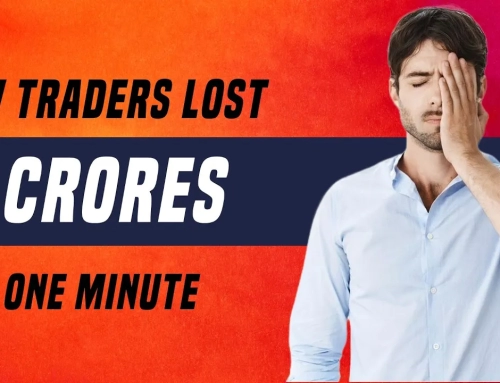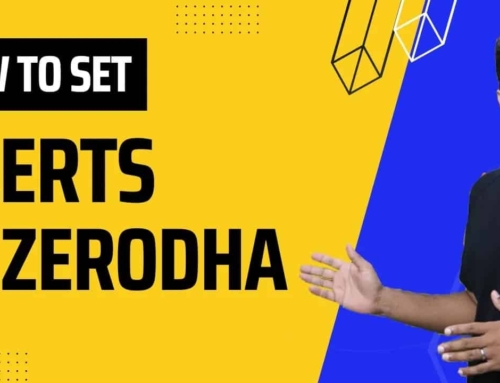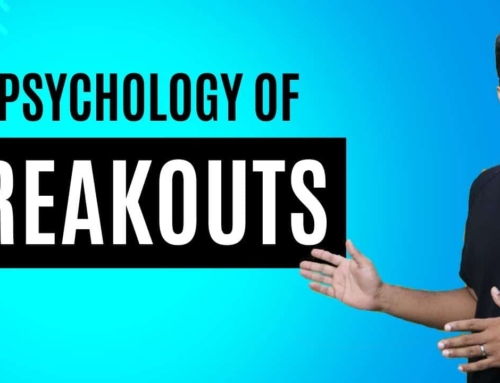Stop Loss- Which One is Better?
Placing a stop loss and trading is just as important as putting on a helmet. When you’re driving on a very busy freeway, you know that, despite having several years of driving experience, you can still get into an accident and if you’re not putting on that helmet, you are exposing yourself to some very grave risk.
Similarly, you might be a professional trader and might be trading for several years. However, if you do not put your stop loss, you are exposing yourself to some real big risk in the stock market. Because stock loss is so important, we have created a series of videos where we have explained step-by-step what is stop-loss? What are the different types of stop-losses? What are the different mistakes that people make by placing these stop losses? And what are the strategies that one should use for coming up with their stop losses?
Hence, I strongly recommend you to watch all those videos so that you can get a very good understanding of what stop-losses are and how to use them in real life.
In this video, we’re going to talk about very specifically the 2 types of stop losses and which one you should be using in your trading. As we know, there are 2 types of stop losses, stop loss limit and stop-loss market order.
Let’s try to understand first how these things work, and then we will get to the point as to which one is better and why.
We’ll first start with a stop-loss market order. For example, you bought a stock at one hundred rupees. You’re expecting the stock to go up and make you some profits, but at the same time, you understand that the stock might not go in your way and want to cut your losses in case the stock starts to decline.
You define that if the stock comes down to 95 rupees, you want to be out of this trade and that is your maximum loss. So what you do here is that you place a stop-loss market order, and the way you do it is to define something called Trigger price. A trigger price, as the name indicates, is a price at which the order gets triggered.
In this example, if you are placing your stop-loss market order at a trigger price of 95, as soon as the stock comes down to 95, the order gets triggered and it is sent to the stock exchange as a market order. The order then gets immediately executed at the market price.
Now let’s talk about what is guaranteed and what is not guaranteed in a stop-loss market order. So what is guaranteed is the execution. It means that as soon as the trigger price is reached, your order will be executed. So you will be out of the trade, but what is not guaranteed is the price at which the order will get executed. If you are lucky, you probably will get a price of 95 or maybe 96, but if you are unlucky, then you can get a price of, let’s say 94, 93 rupees or 92 rupees.
It depends on how fast the stock is falling and so that is how stop-loss market order works.
Now let’s talk about the stop-loss limit order. So when you’re placing a stop-loss limit order, let’s use the same example that you bought the stock at a hundred rupees. You have to define 2 prices in your stop-loss limit order.
One is the trigger price, the same price that we did earlier in the stop-loss market order, which triggers your order. Assume that your trigger price, in this case, is 95. Then the next price that you define is the limit price and assume the limit price is 94.50. So when you are defining a limit price, you’re telling the stock exchange that this is the maximum loss that I’m willing to take.
I will accept any price, which is better than this price, or at least the same as this price, but not below this price. So again, what is guaranteed and what is not guaranteed in a stop-loss limit order?
Now, what is guaranteed is that the price that you defined in your limit price. The execution price will be better than it, or at least the same as your limit price, but what is not guaranteed is the execution itself.
This is what you have to understand when you’re using the stop-loss limit orders because if you don’t understand this, then you’re taking some huge risks.
Let me explain. For example, your stock is falling very rapidly and it falls from a hundred rupees to 95 and your order gets triggered and your order goes as a limit order to the stock exchange at 94.5.
But if the stock is falling because of some bad news or something really bad which happened in the market at that time and if no buyer is sitting to buy at that 94.50, the price also basically skips that level and comes down to 94, 93 or even 92, your order will still sit there waiting for somebody to buy at 94.5, but the price of the stock is falling continuously.
What is mounting are your losses. The losses can go from 5,000 to 10,000, 10,000 to 20,000 and also 20,000 to 30,000 and the whole purpose of having the stop loss is lost. That is a problem in the stop-loss limit order. So a lot of you might be getting an idea about which type of a stop-loss order do I prefer but let me give you a quick example to illustrate my point a little better.
For example, you’re travelling and you are staying in a hotel for a night. You’re just relaxing at night and took a little nap. Suddenly, a fire breaks in your hotel room and as soon as you realize that there is a fire in your room, you have to make a decision.
So you have two choices. Number 1, you can dash to the door and get out of the room as soon as possible. Number 2 is that you can stay there and you can try to collect as many things as possible so that you can save them. It can be your suitcase, shoes, clothes, or whatever you took along with you.
What is guaranteed when you are rushing to the door is that you will be safe and your life will be saved, but what is not guaranteed is that your stuff might survive. It most likely will not survive. That is the case when you choose option number 1.
What if you choose option number 2, what is guaranteed?
Well, the guarantee is that probably you will be able to save some of the stuff, but what is not guaranteed is that you might not survive in the same fire. In the same way, were the stop-loss market order and a stop-loss limit order. In case of a stop-loss market order, what is guaranteed is that you will be out of the trade and whatever loss that you have taken, you will take that loss and at least your capital will be preserved.
But if you place a stop plus limit order, and something really bad happens to the stock, then you might be stuck at that trade and your losses might be mounting. Whatever negotiation that you were trying to do with the market is useless at that point. That makes sense and hence always use a stop-loss market order.
However, despite all this, if you are still interested in placing stop-loss limit orders, I have a few recommendations for you.
The first recommendation that I have is that place stop-loss limit orders only on the liquid stocks or liquid scripts, for example, top 10 or 15 stocks in the F&O segment or maybe Nifty or Bank Nifty.
The second recommendation is that when you’re placing your limit price, put it at a price, which is a whole number.
Let us say 94, 95 or 96, rather than placing it at 94.2, 94.3 or 94.35. This is because if something really bad happens in that stock or with the market itself, then at least you will not be exposing yourself to that price getting skipped all of a sudden.
The third recommendation is that your Trigger price and Limit price should be a little far apart.
The reason being, if 95 is your target price and you are placing your limit price as 94.5, you are giving a very small room for the order to work out. If the stock is falling rather quickly, the chances of your order getting executed are less, but if you keep your trigger price as 95 and you keep your limit price as 94, then you have all these price points at 94.9, 94.8 and 94.7 at which your order can potentially get executed and you will get an exit. So follow these 3 points if you still want to use the limit orders. As far as I am concerned, I do not like and do not use stop-loss limit orders.
However, what we have done is that at VRD Nation, we have developed a unique stop-loss strategy where we have 2 stop losses, not 1. One in the system and the other one that we monitor on our own. We have developed strategies in such a way that we do not wait for our system stop-loss to get triggered.
The system stop loss is still market-based. It’s not limited but still market-based, but we do not wait for it to get triggered. We are out as soon as the trade is not working out and we do not wait for the worst-case scenario to work out for us.
I hope that with these examples and analogies, you will have a very good understanding of stop-loss limit order and stop-loss market order.
I hope and pray that you will not be exposing yourself to huge risks by picking the stop-loss limit orders. Again, stop-loss is so important that we have created a series of videos that explains step by step, what stop losses are, how to place them, what are the different strategies for placing stop-losses and what are the different mistakes that people make when placing stop-losses?
So, do watch all of them to get a comprehensive understanding of stop losses. If you have any questions, feel free to ask in the comments section below. And if you have not subscribed, subscribe right away, because there is so much to learn in the stock market and we will make it easier for you.
Stop Loss- Which One is Better?
Placing a stop loss and trading is just as important as putting on a helmet. When you’re driving on a very busy freeway, you know that, despite having several years of driving experience, you can still get into an accident and if you’re not putting on that helmet, you are exposing yourself to some very grave risk.
Similarly, you might be a professional trader and might be trading for several years. However, if you do not put your stop loss, you are exposing yourself to some real big risk in the stock market. Because stock loss is so important, we have created a series of videos where we have explained step-by-step what is stop-loss? What are the different types of stop-losses? What are the different mistakes that people make by placing these stop losses? And what are the strategies that one should use for coming up with their stop losses?
Hence, I strongly recommend you to watch all those videos so that you can get a very good understanding of what stop-losses are and how to use them in real life.
In this video, we’re going to talk about very specifically the 2 types of stop losses and which one you should be using in your trading. As we know, there are 2 types of stop losses, stop loss limit and stop-loss market order.
Let’s try to understand first how these things work, and then we will get to the point as to which one is better and why.
We’ll first start with a stop-loss market order. For example, you bought a stock at one hundred rupees. You’re expecting the stock to go up and make you some profits, but at the same time, you understand that the stock might not go in your way and want to cut your losses in case the stock starts to decline.
You define that if the stock comes down to 95 rupees, you want to be out of this trade and that is your maximum loss. So what you do here is that you place a stop-loss market order, and the way you do it is to define something called Trigger price. A trigger price, as the name indicates, is a price at which the order gets triggered.
In this example, if you are placing your stop-loss market order at a trigger price of 95, as soon as the stock comes down to 95, the order gets triggered and it is sent to the stock exchange as a market order. The order then gets immediately executed at the market price.
Now let’s talk about what is guaranteed and what is not guaranteed in a stop-loss market order. So what is guaranteed is the execution. It means that as soon as the trigger price is reached, your order will be executed. So you will be out of the trade, but what is not guaranteed is the price at which the order will get executed. If you are lucky, you probably will get a price of 95 or maybe 96, but if you are unlucky, then you can get a price of, let’s say 94, 93 rupees or 92 rupees.
It depends on how fast the stock is falling and so that is how stop-loss market order works.
Now let’s talk about the stop-loss limit order. So when you’re placing a stop-loss limit order, let’s use the same example that you bought the stock at a hundred rupees. You have to define 2 prices in your stop-loss limit order.
One is the trigger price, the same price that we did earlier in the stop-loss market order, which triggers your order. Assume that your trigger price, in this case, is 95. Then the next price that you define is the limit price and assume the limit price is 94.50. So when you are defining a limit price, you’re telling the stock exchange that this is the maximum loss that I’m willing to take.
I will accept any price, which is better than this price, or at least the same as this price, but not below this price. So again, what is guaranteed and what is not guaranteed in a stop-loss limit order?
Now, what is guaranteed is that the price that you defined in your limit price. The execution price will be better than it, or at least the same as your limit price, but what is not guaranteed is the execution itself.
This is what you have to understand when you’re using the stop-loss limit orders because if you don’t understand this, then you’re taking some huge risks.
Let me explain. For example, your stock is falling very rapidly and it falls from a hundred rupees to 95 and your order gets triggered and your order goes as a limit order to the stock exchange at 94.5.
But if the stock is falling because of some bad news or something really bad which happened in the market at that time and if no buyer is sitting to buy at that 94.50, the price also basically skips that level and comes down to 94, 93 or even 92, your order will still sit there waiting for somebody to buy at 94.5, but the price of the stock is falling continuously.
What is mounting are your losses. The losses can go from 5,000 to 10,000, 10,000 to 20,000 and also 20,000 to 30,000 and the whole purpose of having the stop loss is lost. That is a problem in the stop-loss limit order. So a lot of you might be getting an idea about which type of a stop-loss order do I prefer but let me give you a quick example to illustrate my point a little better.
For example, you’re travelling and you are staying in a hotel for a night. You’re just relaxing at night and took a little nap. Suddenly, a fire breaks in your hotel room and as soon as you realize that there is a fire in your room, you have to make a decision.
So you have two choices. Number 1, you can dash to the door and get out of the room as soon as possible. Number 2 is that you can stay there and you can try to collect as many things as possible so that you can save them. It can be your suitcase, shoes, clothes, or whatever you took along with you.
What is guaranteed when you are rushing to the door is that you will be safe and your life will be saved, but what is not guaranteed is that your stuff might survive. It most likely will not survive. That is the case when you choose option number 1.
What if you choose option number 2, what is guaranteed?
Well, the guarantee is that probably you will be able to save some of the stuff, but what is not guaranteed is that you might not survive in the same fire. In the same way, were the stop-loss market order and a stop-loss limit order. In case of a stop-loss market order, what is guaranteed is that you will be out of the trade and whatever loss that you have taken, you will take that loss and at least your capital will be preserved.
But if you place a stop plus limit order, and something really bad happens to the stock, then you might be stuck at that trade and your losses might be mounting. Whatever negotiation that you were trying to do with the market is useless at that point. That makes sense and hence always use a stop-loss market order.
However, despite all this, if you are still interested in placing stop-loss limit orders, I have a few recommendations for you.
The first recommendation that I have is that place stop-loss limit orders only on the liquid stocks or liquid scripts, for example, top 10 or 15 stocks in the F&O segment or maybe Nifty or Bank Nifty.
The second recommendation is that when you’re placing your limit price, put it at a price, which is a whole number.
Let us say 94, 95 or 96, rather than placing it at 94.2, 94.3 or 94.35. This is because if something really bad happens in that stock or with the market itself, then at least you will not be exposing yourself to that price getting skipped all of a sudden.
The third recommendation is that your Trigger price and Limit price should be a little far apart.
The reason being, if 95 is your target price and you are placing your limit price as 94.5, you are giving a very small room for the order to work out. If the stock is falling rather quickly, the chances of your order getting executed are less, but if you keep your trigger price as 95 and you keep your limit price as 94, then you have all these price points at 94.9, 94.8 and 94.7 at which your order can potentially get executed and you will get an exit. So follow these 3 points if you still want to use the limit orders. As far as I am concerned, I do not like and do not use stop-loss limit orders.
However, what we have done is that at VRD Nation, we have developed a unique stop-loss strategy where we have 2 stop losses, not 1. One in the system and the other one that we monitor on our own. We have developed strategies in such a way that we do not wait for our system stop-loss to get triggered.
The system stop loss is still market-based. It’s not limited but still market-based, but we do not wait for it to get triggered. We are out as soon as the trade is not working out and we do not wait for the worst-case scenario to work out for us.
I hope that with these examples and analogies, you will have a very good understanding of stop-loss limit order and stop-loss market order.
I hope and pray that you will not be exposing yourself to huge risks by picking the stop-loss limit orders. Again, stop-loss is so important that we have created a series of videos that explains step by step, what stop losses are, how to place them, what are the different strategies for placing stop-losses and what are the different mistakes that people make when placing stop-losses?
So, do watch all of them to get a comprehensive understanding of stop losses. If you have any questions, feel free to ask in the comments section below. And if you have not subscribed, subscribe right away, because there is so much to learn in the stock market and we will make it easier for you.



![What is Virtual Contract Note [Zerodha]](https://www.vrdnation.com/wp-content/uploads/2023/10/maxresdefault-virtual-note-500x383.jpg)



Leave A Comment